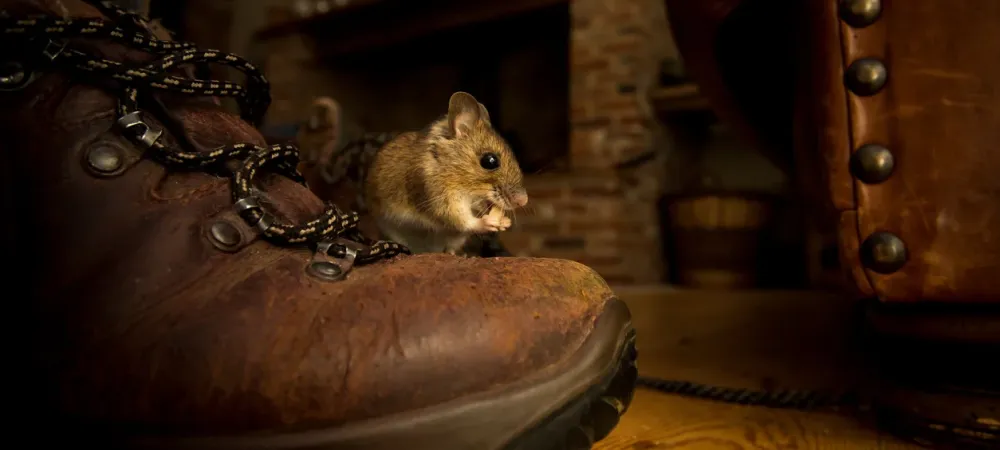How to Deal With Mice in Your Home

If mice are problematic for you every year or you see droppings every once in a while around your home, it is important to understand some information about mice and how they may be causing more damage than you thought.
What Mice Look Like
The common house mouse measures about 3 ½ inches and weighs less than an ounce. Mice have lived up to six years; however, most have a life expectancy of less than one. They produce young year-round with an average litter of six being reared every 50 days. Two mice can grow into a major problem in only a few months. What’s more, mice can:
- Run 30 feet straight up a block wall
- Jump 12 inches high
- Jump from eight feet without injury
- Squeeze through an opening the size of a dime
- Thrive at temperatures no warmer than 14 degrees F.
Signs of a Mouse Infestation
While visual evidence of a mouse (living or dead) is the most obvious sign that you have a mouse problem, there are other ways to tell if your house is hosting unwanted visitors. Those signs include:
- Droppings: Fecal pellets are often left behind in places where food is stored, such as the kitchen, cabinets or pantries, as well as under sinks, inside cardboard boxes and along baseboards.
- Gnaw Marks: Rodents can chew through almost any type of material, including plastic and lead pipes, to obtain food or water. House mice and Norway rats are also known to gnaw on wires behind walls, increasing the risk of fire in the home.
- Nest: Rodents prefer to nest in dark, secluded areas where there is little chance of disturbance. House mice like to build nests out of items like shredded paper products, cotton, wall insulation and fabrics.
- Tracks or Rub Marks: Rats tend to leave dark grease or dirt marks from their oily fur along walls and floorboards as they follow a trail throughout the home between their nest and food.
- Strange Noises: Hearing strange noises in the wall, especially at night, can be a bit concerning. Chances are these sounds can be attributed to a family of rodents scurrying about the house, between the walls and up in attics. Rodents love dark, secluded spots to build nests.
Problems Mice Can Cause
While mice seem harmless enough, they create a number of problems. One mouse feeds 15 to 20 times each day, consuming five to ten times its body weight in a single month, creating nearly 1,400 fecal droppings. Mice have been known to:
- Damage both dry goods and stored food
- Gnaw telephone and security alarm wires
- Cause odor problems from urine-soaked nests in walls
- Carry fleas, mites, and other parasitic pests
- Contribute to asthma in children
- Carry various bacterial and virus-based illnesses
In addition to the nuisance of hearing mice scampering inside walls and attics, a number of medical maladies have been caused by contamination related to mice, their fecal droppings, and their urine. Salmonella food poisoning, infectious jaundice, rickettsialpox, meningitis, tapeworm, hantavirus, asthma, and a number of other diseases can all be associated with mice.
Mice vs Rats
Rats are several times larger than mice. A mouse is only a couple of inches long, plus another couple inches in tail length. On the other hand, Norway and roof rats (the most common type of rat to invade homes) measure well over a foot long, plus tail length. Consequently, their droppings are different sizes. Mouse droppings are ⅛- to ¼-inch long, while rats produce droppings that are about ½- to ¾-inch long. In addition to being different sizes, the droppings are different colors and shapes as well. Mouse droppings are small and smooth, while rat droppings are black and shiny. Mice also have small teeth, so their bits marks look like scratches—rats have big teeth and leave big teeth marks.
How Can I Get Rid of Mice?
Mice are both nocturnal and crepuscular—they are active at night, and also during the dawn and twilight hours. Because they move around in the dark, their eyesight isn’t that great. Instead, mice rely on their highly developed sense of smell to navigate and find food. If you eliminate their food source, you’ll help curb your mouse problem. Keeping your home neat and tidy will go a long way to reducing hiding areas and food sources. Scent-based deterrents are particularly useful for controlling mice.
Contact Your Local Rodent Exterminator
It is necessary to address both outside and inside areas in mouse control programs. Professional outside feeding stations are often required to eliminate mouse activity outside a structure. Rodent baits should be used judiciously inside a structure to avoid accidental contact by children and pets. Multiple catch mouse traps and snap traps are effective when properly placed along mouse runways. Inside services usually require initial treatment with one to three follow up visits depending on the problem. Preventive maintenance programs such as our Eco Guard and Eco Premium plans are often highly recommended or even necessary to help detect and prevent mouse activity in the future. Our technician's service Orchard Park, Williamsville, and the surrounding areas in Buffalo, NY.

